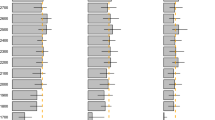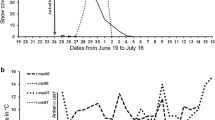Abstract
During four breeding seasons, 2003–2006, we studied the relationship between snow cover and nesting performance in pink-footed geese (Anser brachyrhynchus) in a key breeding site on Svalbard. Snow cover in late May, i.e., at the time of egg laying of geese, was derived from MODIS satellite images. Snow cover had a profound cascading effect on reproductive output via the number of nesting pairs and timing of nesting, which affected nest success, while there was only a tendency for a negative effect on clutch size. Hence, we estimated a five-fold difference in the number of young produced (to post-hatching) between years with little snow and years with high snow cover. The results from the study area correlated with whole-population productivity estimates recorded in autumn. Thus, snow cover derived from MODIS satellite images appears to provide a useful indicator of the breeding conditions in the Arctic.





Similar content being viewed by others
References
Alisauskas RA (2002) Arctic climate, spring nutrition, and recruitment in midcontinent lesser snow geese. J Wildl Manage 66:181–193
Bêty J, Gauthier G, Giroux J-F (2003) Body condition, migration, and timing of reproduction in snow geese: a test of the condition-dependent model of optimal clutch size. Am Nat 162:110–121
Boyd H (1982) Influence of temperature on Arctic-nesting geese. Aquila 89:259–269
Boyd H (1987) Do June temperatures affect the breeding success of Dark-bellied Brent Geese? Bird Study 34:155–159
Davis JB, Kaminski RM, Stephens SE (1998) Wood duck eggshell membranes predict duckling numbers. Wildl Soc Bull 26:299–301
Ebbinge BS (1989) A multifactorial explanation for variation in breeding performance of brent geese Branta bernicla. Ibis 131:196–204
Ebbinge BS, Spaans B (1995) The importance of body reserved accumulated in spring staging areas in the temperate zone for breeding in dark-bellied brent geese Branta b. bernicla in the High Arctic. J Avian Biol 26:105–113
Fox AD, Bergersen E (2005) Lack of competition between barnacle geese (Branta leucopsis) and pink-footed geese (Anser brachyrhynchus) during the pre-breeding period in Svalbard. J Avian Biol 36:173–178
Fox AD, Francis IS, Bergersen E (2006) Diet and habitat use of Svalbard Pink-footed Geese Anser brachyrhynchus during arrival and pre-breeding periods in Adventdalen. Ardea 94:691–699
Ganter B, Madsen J (2001) An examination of methods to estimate population size in wintering geese. Bird Study 48:90–101
Gauthier G, Bety J, Hobson KA (2003) Are greater snow geese capital breeders? New evidence from a stable-isotope model. Ecology 84:3250–3264
Glahder C, Fox AD, Madsen J, Hübner C, Tombre I (2006) Pre-nesting site use of satellite transmitter tagged Svalbard pink-footed geese Anser brachyrhynchus. Ardea 94:679–690
Glahder C, Fox AD, O’Connell M, Jespersen M, Madsen J (2007) Eastward moult migration of non-breding pink-footed geese (Anser brachyrhynchus) in Svalbard. Polar Res 26:31–36
Hoyt DF (1979) Practical methods of estimating volume and fresh weight of bird eggs. Auk 96:73–77
Inglis IR (1977) The breeding behaviour of the pink-footed goose: behavioural correlates of nesting success. Anim Behav 25:747–764
Jepsen JU, Eide NE, Prestrud P, Jacobsen LB (2002) The importance of prey distribution in habitat use by arctic foxes (Alopex lagopus). Can J Zool 80:418–429
Johnson SR, Noel LE (2005) Temperature and predation effects on abundance and distribution of Lesser Snow Geese in the Sagavanirktok River Delta, Alaska. Waterbirds 28:292–300
Klaassen M (2003) Relationships between migration and breeding strategies in Arctic breeding birds. In: Berthold P, Gwinner E, Sonnenschein E (eds) Avian Migration. Springer, Heidelberg, pp 237–249
Klaassen M, Abraham KF, Jefferies RL, Vrtiska M (2006) Factors affecting the site of investment, and the reliance on savings for arctic breeders: the capital-income dichotomy revisited. Ardea 94:371–384
Lepage D, Desrochers A, Gauthier G (1999) Seasonal decline of growth and fledging success in snow geese Anser caerulescens: an effect of date or parental quality? J Avian Biol 30:72–78
MacInnes CD, Davies RA, Jones RN, Leiff BC, Pakulak AJ (1974) Reproductive efficiency of McConnell River Small Canada Geese. J Wildl Manage 38:686–707
Madsen J, Bregnballe T, Mehlum F (1989) Study of the breeding ecology and behaviour of the Svalbard population of light-bellied brent goose Branta bernicla hrota. Polar Res 7:1–21
Madsen J, Bregnballe T, Frikke J, Kristensen JB (1998) Correlates of predator abundance with snow and ice conditions and their role in determining timing of nesting and breeding success in Svalbard light-bellied brent geese (Branta bernicla hrota). Norsk Polarinst Skr 200:221–234
Madsen J, Cracknell G, Fox AD (1999) Goose populations of the Western Palearctic. A review of status and distribution. Wetlands International Publication No. 48. Wetlands International, Wageningen, The Netherlands. National Environmental Research Institute, Rønde, Denmark
Mehlum F (1998) Areas in Svalbard important for geese during the pre-breeding, breeding and post-breeding periods. Norsk Polarinst Skr 200:41–55
Meltofte H, Høye TT, Schmidt NM, Forchhammer MC (2007) Differences in food abundance cause inter-annual variation in the breeding phenology of high Arctic waders. Polar Biol 30:601–606
Owen M, Norderhaug M (1977) Population dynamics of Barnacle Geese Branta leucopsis breeding in Svalbard, 1948–1976. Ornis Scand 8:161–174
Owen M (1980) Wild geese of the world. Batsford, London
Owen M, Black JM (1989) Factors affecting the survival of barnacle geese on migration from the breeding grounds. J Anim Ecol 58:603–617
Prop J, de Vries J (1993) Impact of snow and food conditions on the reproductive performance of barnacle geese (Branta leucopsis). Ornis Scand 24:110–121
Raveling DG (1978) The timing of egg-laying by northern geese. Auk 95:294–303
Reed ET, Gauthier G, Giroux J-F (2004) Effects of spring conditions on breeding propensity of greater snow goose females. Anim Biodivers Conserv 27:35–46
Reeves HM, Cooch FG, Munro RE (1976) Monitoring arctic habitat and goose production by satellite imagery. J Wildl Manage 40:532–541
Ricklefs RE, Starck JM (1998) Embryonic growth and development. In: Starck JM, Ricklefs RE (eds) Avian growth and development, evolution within the altricial-precocial spectrum. Oxford University Press, New York, pp 31–58
Romanoff AL (1960) The avian embryo, structural and functional development. Macmillan, New York
Wisz MS, Tamstorf M, Madsen J, Jespersen M (2007) Which parts of the western Svalbard tundra might be vulnerable to pink-footed goose (Anser brachyrhynchus) population expansion? Clues from habitat models. Divers Distrib (in press)
Acknowledgments
The study was carried out under the EU fifth Framework project FRAGILE (EVK2-2001-00235) and partly supported by a grant from the Research Council for Earth and Life Sciences, the Netherlands Organisation for Scientific Research (ALW–NWO) to MK. For contribution to data collection in the field we thank Espen Bergersen, Tony Fox, Erle Franzén, Ida Eskesen, Ingunn Holoymoen, Eckhart Kuijken, Per Ivar Nicolaisen and Christine Verscheure. University of Svalbard is thanked for supporting the study logistically. The Governor of Svalbard kindly granted us access to Sassendalen and gave permission to collect goose eggs for analysis. This is publication 4055 from the Netherlands Institute of Ecology (NIOO–KNAW). Three anonymous reviewers provided useful comments on the manuscript.
Author information
Authors and Affiliations
Corresponding author
Rights and permissions
About this article
Cite this article
Madsen, J., Tamstorf, M., Klaassen, M. et al. Effects of snow cover on the timing and success of reproduction in high-Arctic pink-footed geese Anser brachyrhynchus . Polar Biol 30, 1363–1372 (2007). https://doi.org/10.1007/s00300-007-0296-9
Received:
Revised:
Accepted:
Published:
Issue Date:
DOI: https://doi.org/10.1007/s00300-007-0296-9




